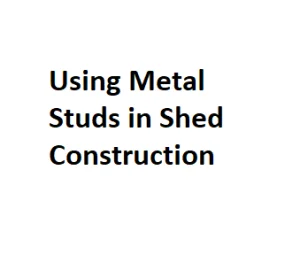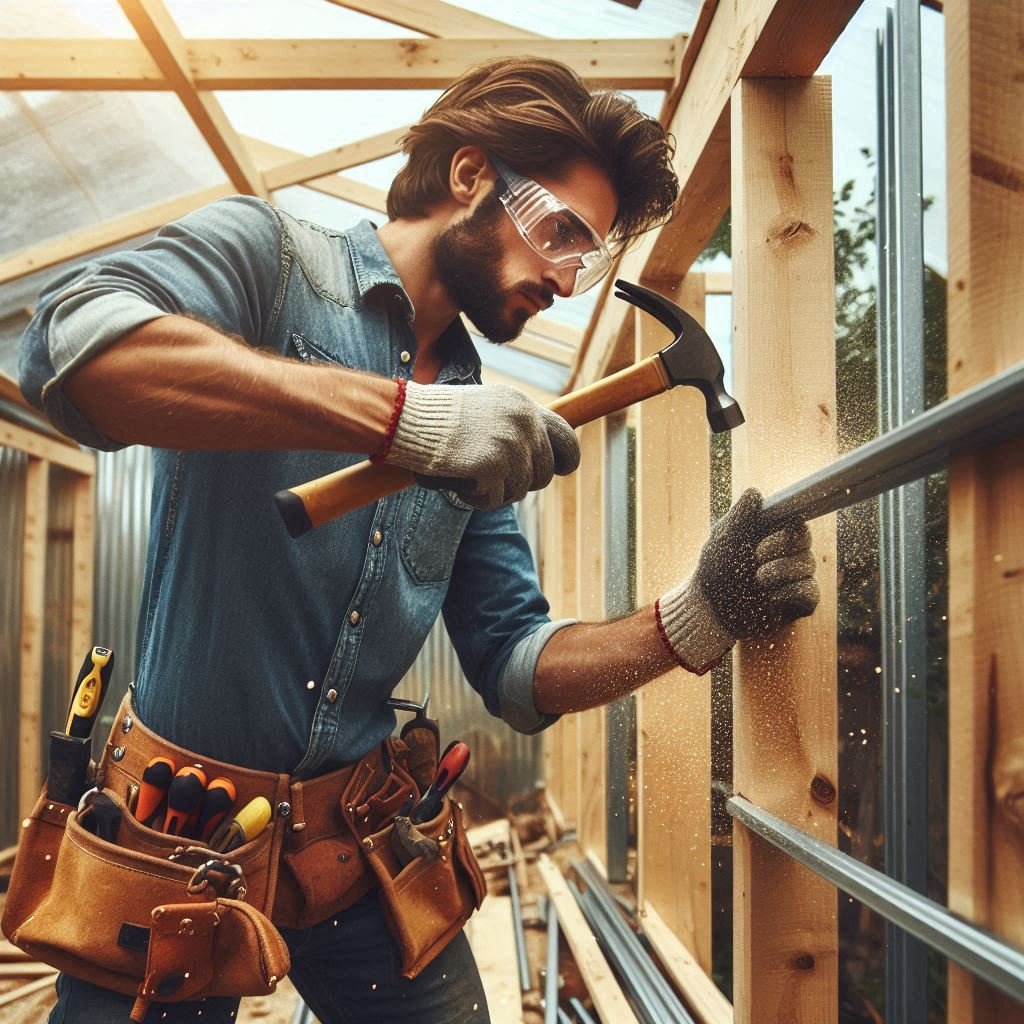When it comes to constructing a shed, the choice of materials can significantly impact the structure’s durability, longevity, and overall performance. While traditional wood framing has been the go-to for many years, there’s a growing trend in the construction industry to explore alternative materials, and one such option is metal studs. In this blog post, we’ll delve into the advantages of using metal studs for shed construction and why they might be the right choice for your next project.
Advantages of Metal Studs:
- Durability and Strength: Metal studs are known for their strength and durability. Unlike wood, which can be susceptible to rot, insects, and warping over time, metal studs are resistant to these issues. This inherent durability ensures that your shed will stand the test of time, requiring less maintenance and repair.
- Resistance to Moisture and Mold: Moisture is a common enemy of sheds, especially in areas with high humidity or frequent rainfall. Metal studs, being non-porous, do not absorb moisture, reducing the risk of mold growth and rot. This resistance makes them an excellent choice for sheds that need to withstand varying weather conditions.
- Consistency and Precision: Metal studs are manufactured to precise dimensions, ensuring a consistent and accurate build. This level of precision can be particularly beneficial when constructing a shed where straight walls and tight connections are essential. Unlike wood, metal studs are not prone to warping or bending, resulting in a structurally sound and aesthetically pleasing final product.
- Fire Resistance: Metal studs are inherently fire-resistant, providing an added layer of safety for your shed. In comparison to wood, which is flammable, metal studs can help reduce the risk of fire damage, offering peace of mind for shed owners concerned about fire safety.
- Environmental Considerations: Metal studs are often made from recycled materials, making them an environmentally friendly choice. Additionally, they are fully recyclable at the end of their lifespan, contributing to sustainability efforts in construction.
Installation Tips:
- Use Appropriate Tools: When working with metal studs, it’s crucial to use tools specifically designed for metal framing. This includes metal-cutting saws, fasteners, and drills. Using the right tools ensures a smooth construction process and helps prevent damage to the studs.
- Protect Against Corrosion: While metal studs are resistant to many environmental factors, it’s essential to protect them from corrosion, especially in areas with high humidity or salt exposure. Consider using galvanized or coated metal studs to enhance their resistance to corrosion.
Choosing the Right Metal Studs:
When considering metal studs for your shed construction, it’s essential to choose the right type of metal. Common materials include steel and aluminum. Steel is known for its strength and durability, making it a popular choice for heavy-duty applications. Aluminum, on the other hand, is lighter and resistant to corrosion, making it suitable for sheds in coastal areas or regions with high humidity.
Cost Considerations:
While the initial cost of metal studs may be higher than that of wood, it’s crucial to factor in the long-term savings. Metal studs require less maintenance, have a longer lifespan, and are less prone to damage from pests and environmental factors. Additionally, the precision in manufacturing can result in less waste during construction, potentially offsetting the initial cost difference.
Adaptability and Design Flexibility:
Metal studs offer versatility in design and construction. They can be easily customized to meet specific design requirements, allowing for creative and unique shed designs. Additionally, metal studs are compatible with a variety of exterior finishes, from traditional siding to modern cladding materials, giving you the flexibility to achieve the aesthetic you desire.
Considerations for DIY Builders:
If you’re planning a do-it-yourself (DIY) shed construction project, working with metal studs might require a bit of a learning curve. However, many online resources and tutorials are available to guide you through the process. Additionally, seeking advice from professionals or consulting with experts at your local hardware store can provide valuable insights and tips for a successful metal stud construction project.
Maintenance and Longevity:
One of the key advantages of using metal studs in shed construction is the minimal maintenance they require. Unlike wood, which may need regular inspections for rot, insect damage, and other issues, metal studs are resistant to these common problems. This resistance translates into a longer lifespan for your shed, reducing the need for frequent repairs and replacements. The durability of metal studs can be particularly beneficial in areas with extreme weather conditions, where the structure needs to withstand heavy rain, snow, or intense sunlight.
Energy Efficiency:
Metal studs contribute to the energy efficiency of your shed. They do not expand or contract with changes in temperature and humidity, ensuring a tight and consistent seal around doors and windows. This characteristic helps in maintaining a controlled climate within the shed, reducing energy costs associated with heating or cooling. Additionally, metal studs can be combined with high-quality insulation materials to further enhance the energy efficiency of the structure.
Structural Integrity:
Metal studs provide excellent structural integrity, offering a stable and secure framework for your shed. This is particularly important if you plan to use the shed for storing heavy equipment or valuable items. The strength of metal studs makes them a reliable choice for ensuring the safety and security of your belongings. It’s important to note that proper installation is key to maximizing the structural benefits of metal studs, so be sure to follow manufacturer guidelines and best practices during construction.
Resilience Against Pests:
While wood is susceptible to termite infestations and other pest-related issues, metal studs are inherently resistant to such problems. This resistance not only reduces the risk of structural damage but also eliminates the need for chemical treatments that are often required to protect wooden structures from pests. Choosing metal studs for your shed construction can contribute to a healthier and more environmentally friendly building process.
Aesthetic Considerations:
Beyond the practical advantages, metal studs offer a sleek and modern aesthetic that can complement various architectural styles. The clean lines and precision of metal framing provide a contemporary look that appeals to those seeking a more modern or industrial design for their sheds. Additionally, the adaptability of metal studs allows for creative architectural features, giving you the freedom to design a shed that stands out in both form and function.
Types of Metal Studs
| Stud Type | Material | Size (inches) | Thickness (gauge) | Usage |
|---|---|---|---|---|
| Track | Galvanized Steel | 3 1/2 x 1 1/4 | 20 | Horizontal framing |
| Stud | Galvanized Steel | 3 5/8 x 1 1/2 | 25 | Vertical framing |
| Corner Stud | Galvanized Steel | 3 5/8 x 1 1/2 | 20 | Corner support |
| Header Stud | Galvanized Steel | 3 1/2 x 1 1/2 | 18 | Roof load bearing |
| Jamb Stud | Galvanized Steel | 3 1/2 x 1 1/4 | 20 | Door/window framing |
Advantages of Metal Studs
| Advantage | Description |
|---|---|
| Lightweight | Easier to handle and transport compared to traditional wood studs. |
| Fire Resistance | Metal studs have better fire resistance compared to wood. |
| Termite and Mold Resistance | Metal is not susceptible to termites or mold, enhancing shed durability. |
| Straight and Consistent | Metal studs are less prone to warping, ensuring a straight and even structure. |
| Recyclable | Environmentally friendly as metal can be recycled after use. |
Challenges of Using Metal Studs
| Challenge | Description |
|---|---|
| Conductivity | Metal conducts heat and cold, which may require additional insulation. |
| Initial Cost | Metal studs can be more expensive initially compared to wood. |
| Limited Load Capacity | May have limitations in supporting heavy loads compared to wood. |
| Specialized Tools | Construction may require specific tools for cutting and fastening metal. |
| Sound Transmission | Metal may transmit sound more effectively than wood, affecting insulation. |
Recommended Tools for Metal Stud Construction
| Tool | Description |
|---|---|
| Metal Stud Cutter | Cuts metal studs with precision. |
| Screw Gun | Fastens screws securely into metal. |
| Aviation Snips | Cuts metal studs easily and accurately. |
| Magnetic Level | Ensures metal studs are plumb and level. |
| Stud Finder | Locates metal studs within walls. |
Tips for Installing Metal Studs
| Installation Tip | Description |
|---|---|
| Use Self-Drilling Screws | Facilitates faster and easier installation of metal studs. |
| Secure Corners with Bracing | Strengthen corners with diagonal bracing for added stability. |
| Space Studs Properly | Follow building codes for stud spacing to ensure structural integrity. |
| Use Insulation with Vapor Barrier | Minimize condensation by using insulation with a vapor barrier. |
| Consider Professional Installation | Complex projects may benefit from the expertise of a professional. |
Final Thoughts:
In the ever-evolving world of construction materials, metal studs have emerged as a compelling option for shed construction. Their durability, resistance to environmental factors, and overall structural benefits make them a practical choice for those looking to build a shed that not only meets but exceeds industry standards. As you embark on your shed construction journey, carefully weigh the advantages of metal studs against other materials, keeping in mind your specific needs, budget, and design preferences. With the right choice of materials, your shed can become a resilient, energy-efficient, and aesthetically pleasing addition to your property.

